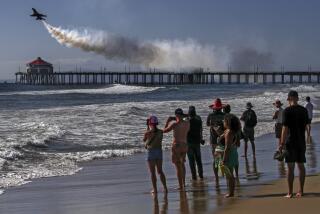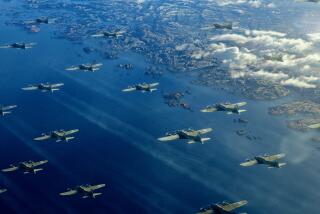O.C. Air Show a High-Flying Crowd Pleaser
EL TORO — With one arm flapping over his head, Lee Oman clung to the wing of his 1940 biplane like a rodeo cowboy. The aircraft bucked right, then left before launching into a perilous ascent, his fluorescent red suit nearly disappearing in the distance.
“It’s beautiful up there,” the 38-year-old wing-walker from Idaho said between performances Saturday at the El Toro Air Show. “I’ve got the best seat in the house.”
From barrel-rolling stunt planes to the precision military fighter jets--including the Blue Angels precision flying team--pilots painted ribbons of white smoke against a bright blue sky for an estimated 650,000 people who jammed the El Toro Marine Corps Air Station on Saturday.
“I think we have a million people in the bag now,” Marine Maj. John Hill, show organizer, said of projected weekend attendance. “Now, it’s how many people do we have over a million. The weather was almost perfect.”
When spectators weren’t locking their necks skyward, most simply reveled in patriotic demonstrations of the military might that contributed to a victory for the U.S.-led allies in the Persian Gulf.
“We really kicked his ass big-time,” a delighted Maj. Gen. Royal N. Moore Jr. barked to the crowd from a platform near the station’s airstrip.
The general’s blunt reference to Iraqi President Saddam Hussein drew a roar from the crowd nearly on par with the thunder of jets flying overhead.
In his brief speech to the spectators, some relaxing on lawn chairs or beach blankets, the commander of the 3rd Marine Aircraft Wing pointed to one aircraft that has been a particular source of pride to him since his recent return from the Gulf: an Iraqi helicopter captured during the allied assault on Kuwait International Airport.
The bulky, sand-colored craft with the Iraqi flag painted on its side sat just off the well-traveled Tarmac exhibit area and in the shadows of the sleek U.S. fighting machines. Moore said the helicopter was a gift made to the 3rd Marine Aircraft Wing by allied ground troops.
Spectators gathered in small groups to peek inside its windows, snap photographs and to read an inscription scrawled in black ink on the helicopter’s skin.
“Captured at Kuwait International Airport Feb. 25, 1991. Delivered proudly and professionally by the Marines of Delta Force.”
Although the main-attraction billing was clearly reserved for the performance of the Navy’s Blue Angels, show organizers never lost an opportunity to display the host Marine Corps’ role in the Gulf fighting.
A full 40 minutes of show time was devoted to an impressive assault re-enactment by the Marine Air-Ground Task Force, complete with helicopter troop drops and fiery airfield explosions.
The task force, which saw considerable action in the Persian Gulf, combines Marine aviation firepower with ground combat troops for quick-response assaults designed to secure military targets.
At one point during the show, the crowd was brought to its feet when two Marine OV-10 Broncos buzzed the reviewing area, pointed their noses into the air and dropped six paratroopers from their bellies.
“Ah, man, that is awesome!” proclaimed Charlie Buchanan, a 37-year-old furniture maker from Vancouver, Canada. “Yeah! Yeah!” he yelled as the powerful AV-8 Harrier rocketed past, leaving mock explosions in its wake.
“I’m quite impressed with the patriotism and the spirit that I see here,” he said. “People are wearing their uniforms and really don’t have to. It’s quite a bit different than last time.”
Spectators continued their cheers as the mock assault proceeded up the airfield. A tank peppered the air with bursts of machine-gun fire, while troops advanced behind it, some diving for cover from make-believe enemy fire.
A short distance away in the exhibit area, hundreds of people swarmed around military aircraft on display for a chance to sit in the cockpit or just listen as veterans of the Gulf War told their stories.
Nine-year-old Christopher Rivers of Newport Beach spent much of his time going through a display of the dreaded MREs (Meals Ready to Eat) as Marine Capt. R.F. Wheeler demonstrated how troops were able to sip water while wearing gas masks.
“It’s pretty weird how they put that stuff on,” Christopher said. “It’s pretty fun. I liked the helmets and (looking) at the icky food.”
One of the longest lines in the exhibit area formed behind the CH-53E Super Stallion helicopter, used to ferry troops and supplies to combat areas in the Persian Gulf.
Tod Beebe of Long Beach and his 8-year-old son, Sean, were among the many who waited several minutes to get a look inside the helicopter’s dark interior.
“I’m fascinated by mechanical things,” Tod Beebe said. “I remember when my dad took me when I was 8 or 10 years old. Now, I’m taking my son. I was sure he’d love it.”
Marine Lance Cpl. Joey Amposta, a hydraulic engineer assigned to the Super Stallion, couldn’t help but smile when he walked past the copter and noticed the number of people waiting for a peek inside.
“These performed really well in Saudi Arabia,” said Amposta, who returned from the Persian Gulf on March 22. “It’s funny, we formed lines just to get off this thing.”
Displays of aircraft technology and aerial acrobatics weren’t the only attractions drawing people to El Toro. Merchants hawking everything from aviation artwork to colorful caps lined the viewing areas.
One of the hottest items going--a $10 framed portrait of allied commanding Gen. H. Norman Schwarzkopf--was selling so fast inside Gil Ortega’s airfield gallery that a call for stock reinforcements went out by midmorning.
Gina Smith, the artist’s daughter, said her mother “was back at home making more.”
The graphite-pencil drawings position the general in front of the American flag.
“I haven’t seen this many people in a long time,” Ortega said.
Marine officials reported that the massive crowd was well-behaved and the bright sunshine claimed only “a few” spectators who complained of heat-related illnesses at first-aid stations.
“It has been real quiet and the people have been real cooperative,” said Marine Capt. John Forquer. “We expect more people tomorrow than we had today.”
That prediction, if true, could put even more strain on the freeways and streets surrounding and inside the base. By 7 a.m. Saturday, roadways in the area were already teeming with vehicles headed for the air show. On base, traffic came to a dead stop in the morning and vehicles formed three lanes of bumper-to-bumper lines into the parking areas.
By midafternoon, hundreds of vehicles were still entering the air station, while traffic was slowed outside by spectators who pulled off to the shoulders of local streets and freeway overpasses to view the show.
More to Read
Sign up for Essential California
The most important California stories and recommendations in your inbox every morning.
You may occasionally receive promotional content from the Los Angeles Times.










